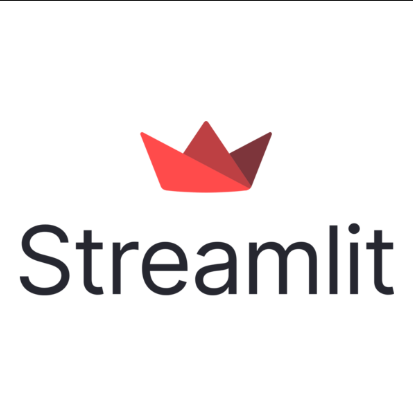Streamlit UI
Streamlit is an open-source Python library for building interactive web apps using only Python. It’s ideal for creating dashboards, data-driven web apps, reporting tools and interactive user interfaces without needing HTML, CSS or JavaScript. Streamlit apps follow a declarative, script-based model:
- Single Python script (streamlit_app.py) runs top-to-bottom on every user interaction.
- Widgets (e.g., sliders, buttons, file uploaders) trigger reruns and act like reactive inputs.
- State management is minimal by default, but can be extended using st.session_state.
- No request/response cycle like Flask or FastAPI — it’s more like a reactive dashboard than a traditional web server.

Use Cases or problem Statement Solved with Streamlit UI:
Statement 1:Wall Detection Tool
Goal: Build a UI to upload architectural floor plans and visualize detected walls with metrics.Provide real-time feedback on wall geometry, detection accuracy, and benchmarking against ground truth.
Statement 2:Model Benchmarking Dashboard
Goal: Design a dashboard to compare model performance across datasets and configurations.Help developers and stakeholders evaluate precision, recall, IoU, and latency in a visual format.
Statement 3:Intent Classification Debugger
Goal: Build a UI to test chatbot inputs and visualize predicted intents and response logic.Accelerate debugging and refinement of conversational AI pipelines with transparency and traceability.
Statement 4:Image Processing Playground
Goal: Create an interactive UI to apply filters, edge detection, and geometric analysis to uploaded images. Allow users to experiment with OpenCV pipelines and visualize transformations step-by-step.
Statement 5:ML Training Monitor (Colab/YOLO)
Goal: Build a UI to track training progress, visualize loss curves, and inspect dataset structure. Simplify troubleshooting and performance tracking during model training in cloud environments.
Pros of Streamlit UI:
- Ultra-fast Prototyping
- Build dashboards, forms, and visualizations in minutes.
- Perfect for internal tools, demos, and iterative workflows.
- Python-native
- No need to learn frontend tech — just use Python.
- Seamless integration with NumPy, Pandas, OpenCV, Matplotlib, Plotly, etc.
- Built-in Widgets
- st.slider, st.selectbox, st.file_uploader, st.button, etc.
- Easy to bind inputs to backend logic.
- Real-time Interactivity
- Widgets trigger reruns automatically.
- Great for parameter tuning, filtering, and live feedback.
- Deployment Simplicity
- Deploy via Streamlit Cloud, Hugging Face Spaces, or Docker.
- No need to manage frontend/backend separation
Cons of Streamlit UI:
- Limited State Management
- No persistent sessions or user-specific data unless manually handled via st.session_state or external storage.
- Not ideal for multi-user apps with login, roles, or long-lived sessions.
- Single-threaded Execution
- Blocking operations (e.g., heavy ML inference) can freeze the UI.
- Requires async workarounds or background threading.
- Not RESTful or Modular by Default
- Hard to separate concerns like in Flask/FastAPI.
- You can’t easily expose endpoints or reuse logic across services.
- Rerun Model Can Be Inefficient
- Every interaction reruns the entire script.
- Can be wasteful for large computations unless cached (@st.cache_data, @st.cache_resource).
- Limited UI Customization
- Styling is minimal — no CSS control.
- Layouts are column-based and can feel rigid for complex UIs.
- Not Meant for Production-Grade Frontends
- No routing, authentication, or frontend frameworks.
- Best suited for internal tools or MVPs.
Alternatives to Streamlit UI:
If you want:
- Fast ML demos with image/audio → Gradio
- Custom dashboards with layout control → Dash
- Full-stack control with REST APIs → FastAPI + React
- Notebook-to-app conversion → Voila
- Modern UI with routing/auth → NiceGUI
Python Implementations:
Step 1. Install Streamlit
Run this in your terminal :
pip install streamlit
Step 2.Create a Python File
Name it something like app.py.
Step 3. Basic UI code
import streamlit as st
# Page title
st.title(“My First Streamlit App”)
# Header and subheader
st.header(“Welcome to the Demo”)
st.subheader(“This is a simple Streamlit UI”)
# Text and markdown
st.text(“This is plain text.”)
st.markdown(“**This is bold markdown text.**”)
# Input widgets
name = st.text_input(“Enter your name”)
age = st.slider(“Select your age”, 0, 100, 25)
# Button
if st.button(“Submit”):
st.success(f”Hello {name}, you are {age} years old!”)
Step 4:Run the App
In your terminal, navigate to the folder and run:
streamlit run app.py
Your browser will open with the UI live!
Answering Some Frequently Asked Questions on Streamlit UI:
1)How is Streamlit different from Flask or Djang
Unlike Flask or Django, which are full-fledged web servers, Streamlit is script-based and reactive — it reruns the entire script on every user interaction.
2)Can I use Streamlit with my existing backend (FastAPI/Django)?
Yes, but Streamlit is not designed for RESTful APIs. You can call your backend endpoints using requests or httpx inside the Streamlit script. For tighter integration, consider separating UI and backend into microservices.
3)Does Streamlit support user authentication and role-based access?
Not natively. You’ll need to implement custom logic using cookies, tokens, or external auth services. For complex auth flows, frameworks like NiceGUI or Dash may be better suited.
4)How do I manage state across user interactions?
Use st.session_state to store variables like counters, flags, or form inputs. For persistent state across sessions, use databases or local storage.
5)Can Streamlit handle file uploads and downloads?
Yes. Use st.file_uploader() to accept files and st.download_button() to let users download processed results.
6)Is Streamlit suitable for production apps?
It’s great for internal tools, dashboards, and MVPs. For multi-user, scalable apps with routing and auth, consider pairing Streamlit with a backend or switching to Dash/FastAPI + React.
7)How do I deploy a Streamlit app?
- Answer: You can deploy via:
- Docker containers
- Hugging Face Spaces
- Heroku, AWS, GCP (with some setup)
8)How do I optimize performance in Streamlit apps?
- Use @st.cache_data for data-heavy operations
- Use @st.cache_resource for models or DB connections
- Avoid rerunning expensive logic on every interaction
Conclusion:
Streamlit is one of the simplest yet most powerful tools in the Python ecosystem. It empowers you to prototype faster, share insights quicker, and create interactive dashboards effortlessly. Whether you’re a data scientist sharing a model, an analyst presenting a dashboard, or a hobbyist building a fun app, Streamlit offers a smooth path from Python script to Web app to Deployed solution. Streamlit revolutionizes the way data professionals build and share data applications. Its ease of use, Python-centric approach, and focus on interactivity make it a go-to choice for rapid prototyping and creating impactful tools. Whether you’re visualizing data, showcasing machine learning models, or building dashboards, Streamlit empowers you to turn your ideas into interactive applications in minutes. Streamlit revolutionizes the way data professionals build and share data applications. Its ease of use, Python-centric approach, and focus on interactivity make it a go-to choice for rapid prototyping and creating impactful tools. Whether you’re visualizing data, showcasing machine learning models, or building dashboards, Streamlit empowers you to turn your ideas into interactive applications in minutes.




